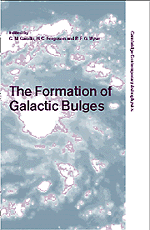Book contents
- Frontmatter
- Contents
- Preface
- Dedication: In Memory of Olin Eggen
- Part 1 Introduction
- Part 2 The Epoch of Bulge Formation
- Origin of Bulges
- Deep sub-mm Surveys: High-z ULIRGs and the Formation of Spheroids
- Ages and Metallicities for Stars in the Galactic Bulge
- Integrated Stellar Populations of Bulges: First Results
- HST-NICMOS Observations of Galactic Bulges: Ages and Dust
- Inside-Out Bulge Formation and the Origin of the Hubble Sequence
- Part 3 The Timescales of Bulge Formation
- Part 4 Physical Processes in Bulge Formation
- Part 5 Bulge Phenomenology
- Part 6 Conference Summary
- Index
HST-NICMOS Observations of Galactic Bulges: Ages and Dust
from Part 2 - The Epoch of Bulge Formation
Published online by Cambridge University Press: 10 November 2010
- Frontmatter
- Contents
- Preface
- Dedication: In Memory of Olin Eggen
- Part 1 Introduction
- Part 2 The Epoch of Bulge Formation
- Origin of Bulges
- Deep sub-mm Surveys: High-z ULIRGs and the Formation of Spheroids
- Ages and Metallicities for Stars in the Galactic Bulge
- Integrated Stellar Populations of Bulges: First Results
- HST-NICMOS Observations of Galactic Bulges: Ages and Dust
- Inside-Out Bulge Formation and the Origin of the Hubble Sequence
- Part 3 The Timescales of Bulge Formation
- Part 4 Physical Processes in Bulge Formation
- Part 5 Bulge Phenomenology
- Part 6 Conference Summary
- Index
Summary
We present a study in B, I and H of a magnitude-limited sample of galactic bulges using WFPC2 and NICMOS. The high spatial resolution of HST allows us to study the dust contents near the center, and stellar populations in dust-free regions. We find extinction in 19/20 galaxies and infer an average central extinction of Av = 0.6 − 1.0 mag. For galactic bulges of types S0 to Sb, the tightness of the B − I vs I − H relation suggests that the age spread among bulges of early type galaxies is small, at most 2 Gyr independent of environment. Comparison with stellar population models shows that the bulges are old. Colors at 1 bulge effective-radius, where we expect extinction to be negligible, suggest that all of these bulges formed around at the same time as bright galaxies in the Coma cluster.
Introduction
The formation of the central bulges of spiral galaxies is an unsolved facet of galaxy formation. There are currently two main scenarios for the formation of bulges: the classical picture (e.g. Eggen, Lynden-Bell & Sandage 1962), where bulge formation is described by collapse of a primordial gas cloud into clumps, which then merge together. The disk forms only after the last massive merger via gas infall. In the second scenario, the secular evolution of disks (e.g. Pfenniger & Norman 1990), a bulge is formed through dynamical instabilities in the disk, which first create a bar, and later a bulge.
- Type
- Chapter
- Information
- The Formation of Galactic Bulges , pp. 46 - 49Publisher: Cambridge University PressPrint publication year: 2000

